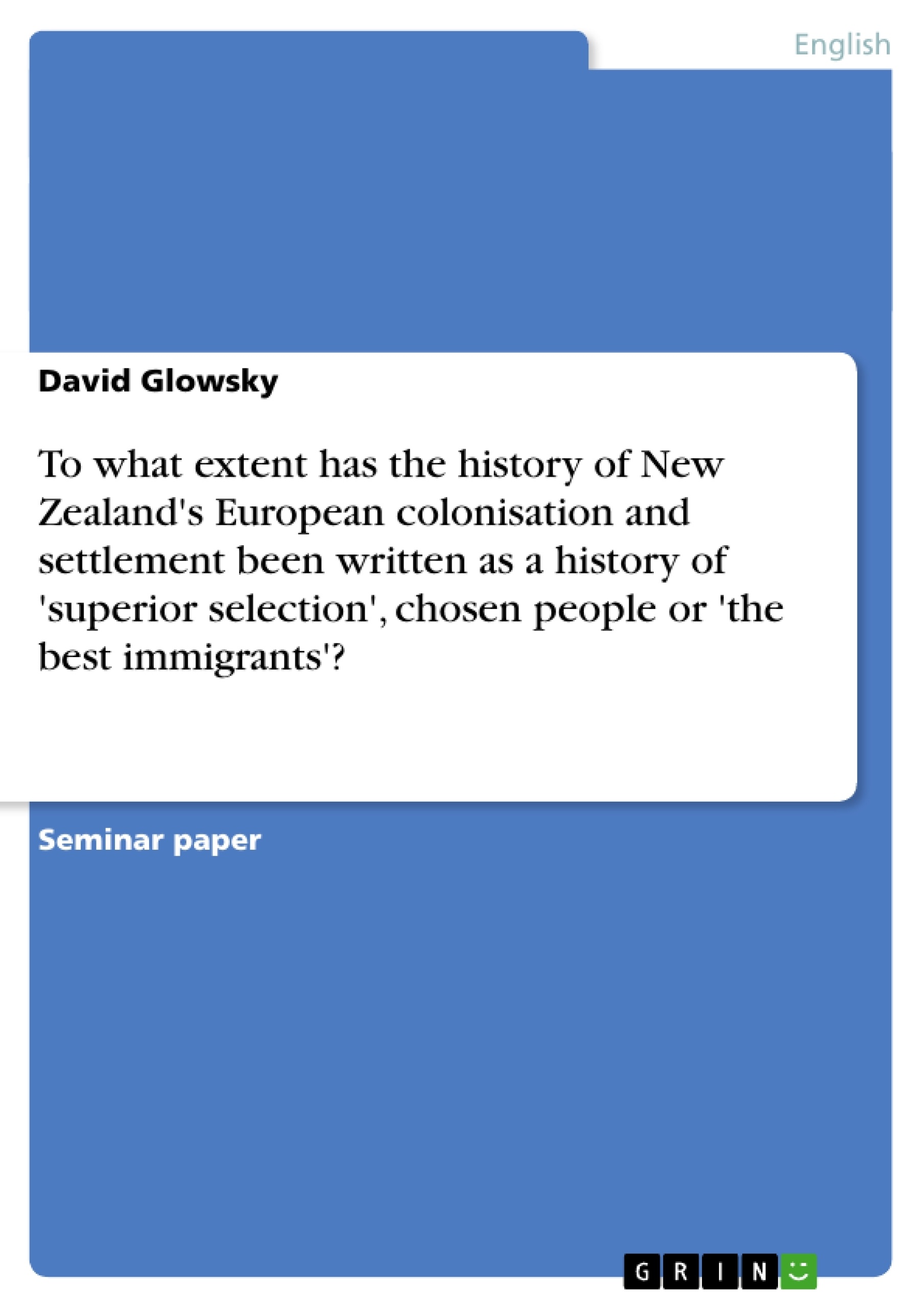Edward Gibbon Wakefield has been a controversial figure in the historiography of New Zealand. Once deified, present historians widely disregard him today. This apparent change in the perception of Wakefield’s theory of ‘systematic colonisation’ and the impact of his New Zealand Company on the quality of immigrants shall be examined in this essay. I have chosen to take five general New Zealand Histories into account, which cover the time span of almost a century. The aim will not be to find any history that has contributed to the myth of the better immigrants, but to examine how a widely spread range of the most regarded concise histories of New Zealand have reflected on this issue.
Inhaltsverzeichnis (Table of Contents)
- Introduction
- Defining 'better immigrants'
- William Pember Reeves: The Long White Cloud. Ao Tea Roa
- Keith Sinclair: A History of New Zealand
- W. H. Oliver: The Story of New Zealand
- The Oxford History of New Zealand
- James Belich: Making Peoples
- Conclusion
Zielsetzung und Themenschwerpunkte (Objectives and Key Themes)
This essay examines the portrayal of Edward Gibbon Wakefield and his "systematic colonisation" theory in five general histories of New Zealand, spanning nearly a century. It investigates whether these histories contribute to the myth of "better immigrants" and how they reflect on the issue of immigration quality.
- The influence of Edward Gibbon Wakefield's "systematic colonisation" theory on immigration to New Zealand
- The portrayal of Wakefield and his theory in different historical accounts
- The myth of "better immigrants" and its impact on New Zealand's history
- The historical perception of immigrants and their contribution to New Zealand society
- The evolving nature of historical narratives and their relationship to the past
Zusammenfassung der Kapitel (Chapter Summaries)
- The introduction sets the context by introducing the controversial figure of Edward Gibbon Wakefield and his theory of systematic colonisation. It outlines the essay's aim to analyze how various New Zealand histories have addressed the issue of immigration quality.
- The "Defining 'better immigrants'" section delves into Wakefield's concept of an ideal immigrant population, highlighting his desire for a balanced society comprising both labourers and "men of capital and intellect". It notes that while historians agree on Wakefield's pursuit of a "better proportion" of immigrants, they differ on the specific composition of this group.
- The chapter on William Pember Reeves' "The Long White Cloud. Ao Tea Roa" examines how Reeves presented Wakefield as a heroic figure who successfully implemented his theory. The analysis focuses on Reeves' glorification of Wakefield's work and his tendency to downplay any potential flaws. The chapter also explores Reeves' portrayal of the immigrants as contributing to a "civilised community" with "men of capital and intellect", but lacks evidence for this claim.
- The chapter about Keith Sinclair's "A History of New Zealand" presents a contrasting view of Wakefield and his theory. Sinclair, writing in a period where Wakefield's reputation was declining, offers a critical analysis of his personality and work. He emphasizes Wakefield's flaws and challenges the idea that his theory was successful. Sinclair argues that New Zealand society did not develop according to Wakefield's expectations and challenges the myth of "better immigrants".
- The chapter on W.H. Oliver's "The Story of New Zealand" provides a more nuanced perspective on Wakefield. Oliver acknowledges Wakefield's intelligence and his potential as a politician but also highlights his limitations. He suggests that Wakefield's theory was compromised by the profit-driven motives of his investors. While recognizing the desired composition of immigrants as "carefully selected labourers" and "young couples of good character", Oliver acknowledges that the actual composition of the immigrant population differed considerably from Wakefield's ideal. He firmly rejects the "Wakefieldian myth" without discrediting Wakefield himself.
Schlüsselwörter (Keywords)
The key terms and concepts central to this essay include Edward Gibbon Wakefield, systematic colonisation, New Zealand history, immigration quality, "better immigrants", historical narrative, myth, and historical perception. It explores the evolving historical interpretations of Wakefield's theory and its impact on the composition of the early New Zealand population.
- Quote paper
- David Glowsky (Author), 2002, To what extent has the history of New Zealand's European colonisation and settlement been written as a history of 'superior selection', chosen people or 'the best immigrants'?, Munich, GRIN Verlag, https://www.grin.com/document/20225




